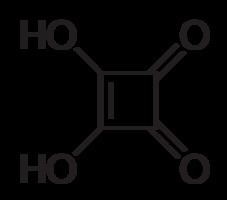Formula C4H2O4 Appearance Gray powder | Molar mass 114.06 g/mol | |
 | ||
Acidity of squaric acid
Squaric acid, also called quadratic acid, because its four carbon atoms approximately form a square, is an organic compound with chemical formula C4H2O4.
Contents
The conjugate base of squaric acid is the hydrogensquarate anion C4HO4−; and the conjugate base of the hydrogensquarate anion is the divalent squarate anion C4O42−. This is one of the oxocarbon anions, which consist only of carbon and oxygen.
Squaric acid is a reagent for chemical synthesis, used for instance to make photosensitive squaraine dyes and inhibitors of protein tyrosine phosphatases.
Chemical properties
Squaric acid is a white crystalline powder with a thermal decomposition point of 245 °C at ambient pressure. The onset of thermal decomposition depends on the different thermodynamic conditions such as heating rates.
The structure of squaric acid is not a perfect square, as the carbon–carbon bond lengths are not quite equal. The high acidity with pKa = 1.5 for the first proton and pKa = 3.4 for the second is attributable to resonance stabilization of the anion. Because the negative charges are equally distributed between each oxygen atom, the dianion of squaric acid is completely symmetrical (unlike squaric acid itself) with all C-C and C-O bond lengths identical.
Another, quantum mechanical, way of describing the dianion is to assume that the π electrons of the two double-bonded oxygen atoms are shifted to the latter, so that all four oxygens become single-bonded -O− groups and a double positive electric charge is left in the ring of carbon atoms. In this way the ring fits Hückel's rule for aromaticity (2 π-electrons = 4n + 2 with n = 0). The total symmetry of the dianion is a consequence of charge distribution and aromaticity.
On the other hand, theoretical calculations indicate that the analogous tetrathiosquarate anion C
4S2−
4 is anti-aromatic.
Derivatives
Photolysis of squaric acid in a solid argon matrix at 10 K (−263.1 °C) affords acetylenediol.
Cobalt(II) squarate hydrate Co(C4O4)(H2O)2 (yellow, cubic) can be prepared by autoclaving cobalt(II) hydroxide and squaric acid in water at 200 °C. The water is bound to the cobalt atom, and the crystal structure consists of a cubic arrangement of hollow cells, whose walls are either six squarate anions (leaving a 7 Å wide void) or several water molecules (leaving a 5 Å void).
Cobalt(II) squarate dihydroxide Co3(OH)2(C4O4)2 3H2O (brown) is obtained together with the previous compound. It has a columnar structure including channels filled with water molecules; these can be removed and replaced without destroying the crystal structure. The chains are ferromagnetic; they are coupled antiferromagnetically in the hydrated form, ferromagnetically in the anhydrous form.
The same method yields iron(II) squarate dihydroxide Fe2(OH)2(C4O4) (light brown).
One or both of the oxygen (=O) groups in the squarate anion can be replaced by other chalcogenides such as sulfur or other divalent groups, such as dicyanomethylene =C(CN)2. The resulting anions, such as 1,2-bis(dicyanomethylene)squarate and 1,3-bis(dicyanomethylene)squarate, retain the aromatic character of squarate and have been called pseudo-oxocarbon anions. There have been theoretical investigations of the analogous compound obtained by substituting amino groups (-NH2) for the hydroxyl (OH) groups to yield 1,2-diamino-3-cyclobutenedione, and of a compound consisting of two squarate rings bridged by (-NH-) bonds to form bis(3-cyclobutene-1,2-dione)piperazine.
Squaramides are amides of squaric acids. They are four membered vinylogously conjugated diamides. Hydrogen bonding occurs at four locations and is aided by delocalisation of electrons on nitrogen's orbitals to the carbonyl group. H-bonding and thus delocalization further increases ring aromaticity.
Syntheses
The original synthesis started from reaction of 1-chloro-1,2,2-trifluoroethylene with zinc to perfluorocyclobutene. This compound was converted to 1,2-diethoxy-3,3,4,4-tetrafluoro-1-cyclobutene with ethanol. Hydrolysis gives the squaric acid.
Squarate and related anions such deltate C
3O2−
3 and acetylenediolate C
2O2−
2 have been obtained from carbon monoxide under mild conditions by reductive coupling of CO ligands in organouranium complexes. A similar route recently afforded carbonate anions (in the form of uranium(IV) carbonate) from carbon dioxide CO2.
Medical uses
Medically, squaric acid dibutylester is used for the treatment of warts. Squaric acid dibutylester is also used for treating alopecia areata or alopecia totalis/universalis (autoimmune hair loss) through topical immunotherapy involving the production of an allergic rash. Squaric acid dibutylester is currently undergoing trials for use in treating herpes labialis (cold sores).
Diethylsquarate was utilized in the synthesis of Perzinfotel.
